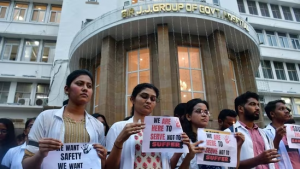
A Doctor’s Death That Shook India
The recent rape and murder of a 31-year-old trainee doctor in Kolkata has sparked widespread outrage and led to a massive strike by nearly 300,000 resident doctors across India. The crime, which took place in a seminar room at RG Kar Medical College and Hospital, has exposed the glaring security deficiencies in Indian medical institutions and ignited a nationwide call for better protection of healthcare workers, especially women.
What Happened to the Trainee Doctor in Kolkata?
On August 9, 2024, the body of a 31-year-old postgraduate trainee doctor was found in a seminar room at the RG Kar Medical College and Hospital in Kolkata. The autopsy report revealed that she had been brutally raped and murdered, with severe injuries indicating intense violence, including broken bones and severe genital trauma. Initially, the hospital administration attempted to label her death as a suicide, sparking further outrage when the truth emerged.
The Nationwide Doctor Strike
The news of the incident spread rapidly, leading to widespread anger among medical professionals. Nearly 300,000 resident doctors in government hospitals across India began an indefinite strike, demanding better safety and security in the workplace. Elective and non-emergency procedures were halted, and protests erupted in cities across the country. Doctors held placards reading, “We demand safety and security in our workplace” and “Hands that heal should not bleed,” reflecting their fear and frustration. The Federation of Resident Doctors Association India (FORDA) and the Federation of All India Medical Association (FAIMA) are at the forefront of this movement, calling for the swift passage of the Central Protection Act for Doctors. This proposed law aims to establish clear definitions and penalties for violence against healthcare workers, addressing the urgent need for better security measures.
Role of Women’s Rights Activists in the Protests
Women’s rights activists quickly mobilized, organizing protests under the banner of “Reclaim the Night.” Thousands of women in West Bengal planned to march late at night, symbolizing their demand for the freedom to live without fear. The protests coincided with India’s Independence Day, raising poignant questions about whether the country’s freedom truly extends to its women.

Kolkata: From Safest City to Crime Scene
Kolkata, once considered one of India’s safest cities for women, now finds itself at the center of a national crisis. The brutal murder at RG Kar Medical College has shattered the city’s image, revealing deep-seated issues of violence against women. The incident has drawn parallels to the infamous 2012 Delhi gang rape, a case that brought global attention to India’s struggle with sexual violence. Despite legislative changes and increased awareness, the problem persists, with women across the country continuing to face threats to their safety.
Statistics Paint a Grim Picture
India’s struggle with sexual violence is far from over. According to the National Crime Records Bureau, over 31,000 rapes were reported in 2022 alone. However, experts believe the actual number is much higher due to the underreporting of such crimes, driven by fear of reprisal and social stigma. Shockingly, a 2015 survey by the Indian Medical Association found that 75% of doctors had experienced violence at work, highlighting the vulnerability of healthcare workers in high-pressure environments. The brutal rape and murder of the Kolkata doctor bear striking similarities to the 2012 Delhi gang rape, which shocked the world and led to widespread protests and changes in the law. Despite these changes, the persistence of such crimes highlights the deep-rooted cultural and social issues that perpetuate violence against women in India. The situation is even more dire for marginalized women, such as Dalits, who face additional layers of discrimination and violence.

The Larger Issue: A Culture of Impunity and Silence
The persistence of sexual violence in India can be attributed to a culture of impunity, where perpetrators often face little to no consequences for their actions. This culture is reinforced by societal norms that blame victims and discourage them from seeking justice. Despite the existence of laws to protect women, the lack of effective enforcement and the reluctance of authorities to act have allowed this crisis to continue unabated.
The Psychological and Cultural Roots of Violence
Understanding the psyche behind the rising violence in India requires a deep dive into the cultural and social factors that perpetuate it. In many parts of the country, traditional gender roles and patriarchal norms dictate that women are subordinate to men. This mindset fosters a sense of entitlement among men, leading to the objectification and control of women’s bodies. Additionally, the lack of comprehensive sex education and awareness about consent contributes to the normalization of violence.
The Intersection of Poverty, Education, and Violence
The problem is further compounded in poorer and rural areas, where limited access to education and healthcare exacerbates the issue. In these regions, the distrust of doctors, particularly female doctors, is common. The combination of poverty, lack of education, and deeply ingrained patriarchal values creates a fertile ground for violence against women.
Why Is There a Lack of Effective Legal Protection for Women in India?
Although 25 out of India’s 28 states have laws protecting doctors and healthcare workers from violence, these laws are often poorly enforced. The Indian Medical Association has called for a Central Protection Act for Doctors, which would create uniform standards and penalties for violence against medical professionals. However, the broader issue of violence against women requires more than just legal reforms; it demands a fundamental shift in societal attitudes and behavior.
The Need for a Multi-Faceted Approach: Changing Minds and Laws
Addressing the crisis of sexual violence in India requires more than just legal reforms. A multi-faceted approach is needed, one that includes widespread education on gender equality, consent, and respect for women’s rights. Schools, communities, and media must play a role in challenging harmful stereotypes and promoting positive, healthy behaviors. Moreover, the government must ensure that laws are not only enacted but also enforced, with timely trials and protection for survivors.
Can India Achieve True Independence for Its Women?
As India celebrates its 78th year of independence, the irony of the situation is stark. The country’s leaders often invoke the image of “Mother India” to symbolize the nation’s strength and resilience, yet the safety and dignity of real women remain under constant threat. The question now is whether this tragedy will serve as a catalyst for meaningful change, or if the cycle of violence and impunity will continue.
The nationwide protests, the strikes by doctors, and the public outcry all signal a growing demand for action. However, achieving true independence for India’s women will require a sustained commitment to dismantling the patriarchal structures that perpetuate violence and inequality.
The Role of Media and Public Discourse: Catalysts for Change or Perpetuators of Harm?
The media plays a critical role in shaping public perceptions of violence against women, particularly in cases as horrific as the one in Kolkata. However, this influence can be a double-edged sword. On one hand, media coverage has the power to bring attention to issues that might otherwise be overlooked, amplifying the voices of victims and demanding accountability from authorities. In the case of the young doctor’s murder, the extensive coverage has been instrumental in rallying public support, leading to nationwide protests and strikes that demand justice and systemic change. The media’s focus on the incident has also sparked broader discussions about the safety of women in public spaces, the vulnerabilities of healthcare workers, and the urgent need for legal reforms.
On the other hand, the way the media reports such incidents can often contribute to the problem. Sensationalist reporting, victim-blaming narratives, and the focus on gruesome details can dehumanize the victim and shift the conversation away from the structural issues that allow such violence to persist. The portrayal of the victim as a tragic figure rather than a professional woman whose life was cut short due to systemic failures can obscure the broader context of gender-based violence. Moreover, when the media sensationalizes cases of sexual violence, it risks fostering a climate of fear rather than one of empowerment. This can discourage women from pursuing careers in male-dominated fields like medicine, where the risks are perceived to be higher, thereby reinforcing gender inequalities.
Public discourse surrounding such crimes is also crucial. Social media platforms, in particular, have become arenas for public debate and activism, where citizens can express outrage, share information, and mobilize support for causes. However, these platforms can also become echo chambers where misinformation spreads rapidly, and where the focus on immediate outrage can eclipse the need for sustained advocacy and policy change. The hashtag-driven campaigns, while effective in drawing attention to specific incidents, often lack the depth required to address the underlying issues comprehensively. To truly leverage the power of public discourse, there needs to be a shift towards more informed and sustained discussions that go beyond individual cases and address the systemic roots of violence against women in India.
The intersection of media, public discourse, and violence against women is complex and fraught with challenges. While the coverage of the Kolkata incident has undoubtedly spurred important conversations and actions, it is imperative that both media and the public approach such incidents with a focus on long-term solutions rather than short-term outrage. This means moving beyond sensationalism to foster a culture of respect and empathy, ensuring that the narratives surrounding violence against women are framed in ways that promote understanding, support survivors, and push for meaningful change. Only then can the potential of media and public discourse be fully realized as tools for combating the epidemic of gender-based violence in India.
A Call for Justice and Change
The rape and murder of a young doctor in Kolkata is not just a tragic incident; it is a symptom of a much larger problem. It is a stark reminder that, despite progress in many areas, India still has a long way to go in ensuring the safety and dignity of its women. The path forward must involve not only legal reforms but also a fundamental shift in societal attitudes. Only then can India hope to create a future where women can live without fear, and healthcare workers can perform their duties without the threat of violence.
